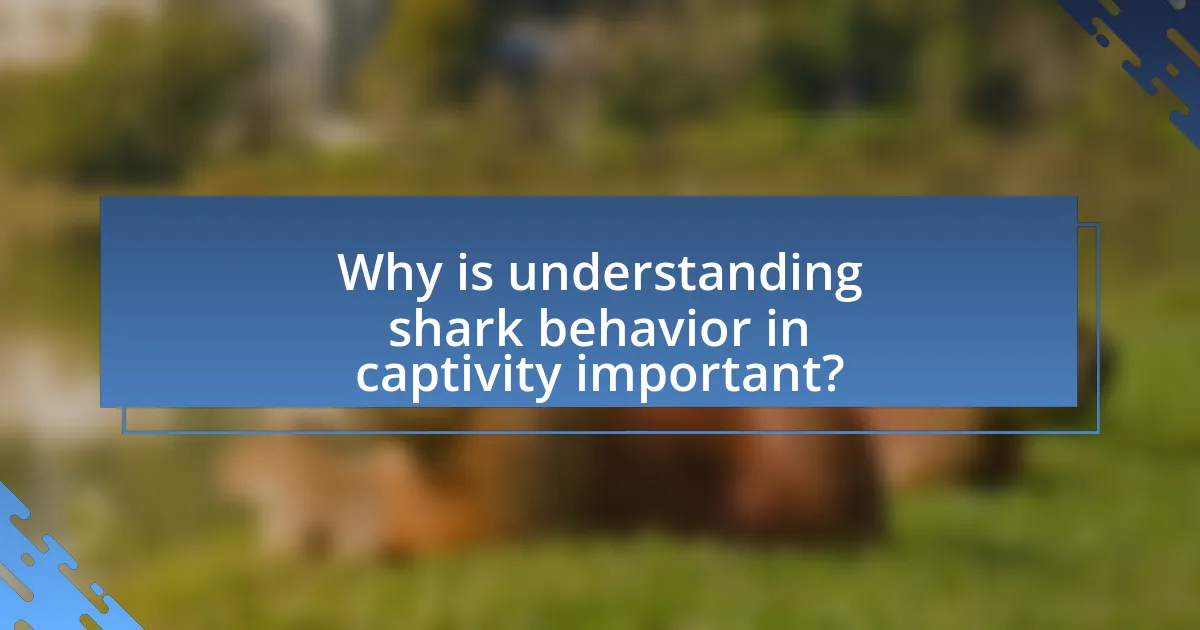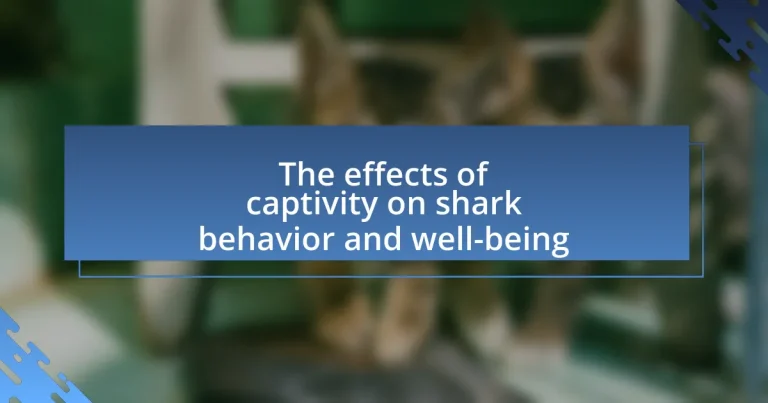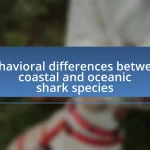The article examines the effects of captivity on shark behavior and well-being, highlighting how confinement induces stress and alters natural behaviors. It discusses the impact of captivity on social interactions, group dynamics, aggression, and territorial behavior, as well as physiological effects such as elevated cortisol levels and compromised immune function. The article also addresses the implications for reproduction and breeding success, the role of environmental enrichment in improving well-being, and the long-term consequences for shark populations, including reduced genetic diversity and altered behaviors. Additionally, it outlines best practices for enhancing the living conditions of sharks in captivity and emphasizes the importance of ethical treatment guidelines.

What are the effects of captivity on shark behavior and well-being?
Captivity negatively impacts shark behavior and well-being by inducing stress and altering natural behaviors. Sharks in captivity often exhibit signs of stress, such as increased aggression, abnormal swimming patterns, and reduced feeding. Research indicates that confined environments can lead to physiological changes, including elevated cortisol levels, which are associated with stress responses. A study published in the journal “Marine Biology” by researchers from the University of Florida found that captive sharks displayed significantly higher stress indicators compared to their wild counterparts, demonstrating the detrimental effects of captivity on their overall health and behavior.
How does captivity impact shark social interactions?
Captivity significantly alters shark social interactions by restricting their natural behaviors and social structures. In the wild, sharks exhibit complex social dynamics, including hierarchies and cooperative hunting, which are often disrupted in confined environments. Research indicates that sharks in captivity may display increased aggression and stress due to limited space and the absence of social partners, leading to abnormal behaviors such as repetitive swimming patterns and reduced social engagement. A study published in the journal “Marine Biology” by researchers from the University of Florida found that captive sharks exhibited fewer social interactions compared to their wild counterparts, highlighting the detrimental effects of confinement on their social behavior.
What changes occur in shark group dynamics in captivity?
Shark group dynamics in captivity often shift towards increased aggression and altered social hierarchies. In natural environments, sharks typically exhibit complex social structures and behaviors, but confinement can lead to stress and competition for limited resources, such as space and food. Research indicates that in captivity, sharks may display heightened territoriality and aggressive interactions, which can result in injuries or even fatalities among individuals. For instance, studies have shown that species like the blacktip reef shark exhibit more aggressive behaviors when housed in smaller enclosures compared to larger, more naturalistic settings. This change in dynamics can significantly impact their overall well-being and health, highlighting the importance of appropriate habitat design in captivity.
How does captivity affect aggression and territorial behavior in sharks?
Captivity increases aggression and alters territorial behavior in sharks. Research indicates that confined environments can lead to heightened stress levels, which in turn can manifest as aggressive interactions among individuals. For instance, studies have shown that sharks in captivity often display increased territoriality due to limited space and resources, leading to more frequent aggressive encounters. A study published in the journal “Marine Biology” by researchers from the University of Florida found that captive sharks exhibited significantly more aggressive behaviors compared to their wild counterparts, primarily due to the constraints of their environment. This evidence underscores the impact of captivity on the behavioral dynamics of sharks, highlighting the challenges they face in artificial settings.
What are the physiological effects of captivity on sharks?
The physiological effects of captivity on sharks include stress responses, altered hormone levels, and changes in immune function. Captive sharks often exhibit elevated cortisol levels, indicating chronic stress, which can lead to compromised immune systems and increased susceptibility to disease. Research has shown that confinement can also result in reduced growth rates and reproductive issues, as seen in studies where captive sharks displayed lower reproductive success compared to their wild counterparts. Additionally, limited space and lack of natural stimuli can lead to abnormal behaviors, further impacting their physiological health.
How does captivity influence stress levels in sharks?
Captivity significantly increases stress levels in sharks. Research indicates that confined environments lead to heightened cortisol levels, a hormone associated with stress responses. For instance, a study published in the journal “Marine Biology” by researchers from the University of Florida found that sharks in captivity exhibited increased aggressive behaviors and reduced immune function, both indicators of stress. Additionally, the lack of space and natural stimuli in aquariums can lead to abnormal swimming patterns and decreased feeding, further exacerbating stress levels.
What are the implications of captivity on shark feeding behavior?
Captivity significantly alters shark feeding behavior, often leading to changes in their natural hunting instincts and feeding patterns. In controlled environments, sharks may become reliant on regular feeding schedules and lose their ability to hunt effectively, as evidenced by studies showing that captive sharks exhibit reduced foraging behaviors compared to their wild counterparts. Research indicates that the lack of environmental stimuli and the absence of natural prey can result in abnormal feeding habits, such as increased aggression during feeding times or a preference for less nutritious food sources provided by aquariums. These behavioral changes can impact their overall health and well-being, highlighting the importance of understanding the implications of captivity on their feeding behavior.

Why is understanding shark behavior in captivity important?
Understanding shark behavior in captivity is important because it directly influences their health, welfare, and the success of conservation efforts. Captive environments can significantly alter natural behaviors, leading to stress and health issues, which can be observed through changes in feeding patterns, social interactions, and overall activity levels. Research indicates that sharks in captivity often exhibit signs of stress, such as increased aggression or lethargy, which can be linked to inadequate tank size and lack of environmental enrichment. For instance, a study published in the Journal of Experimental Marine Biology and Ecology found that larger tank sizes and complex habitats improved the well-being of captive sharks, demonstrating the necessity of understanding their behavior to create optimal living conditions.
How does captivity affect shark reproduction and breeding success?
Captivity negatively affects shark reproduction and breeding success by altering their natural behaviors and physiological conditions. In controlled environments, sharks often experience stress due to limited space, unnatural social structures, and inadequate environmental stimuli, which can lead to reduced reproductive rates. For instance, studies have shown that captive sharks may exhibit lower hormone levels associated with reproduction, impacting their ability to breed successfully. Additionally, the lack of natural mating opportunities and the challenges of artificial breeding techniques can further hinder successful reproduction in captivity.
What are the challenges faced in breeding sharks in captivity?
Breeding sharks in captivity presents several challenges, including difficulties in replicating their natural habitat, understanding their reproductive behaviors, and ensuring genetic diversity. Sharks require specific environmental conditions, such as water temperature, salinity, and space, which are often hard to maintain in artificial settings. Additionally, many shark species exhibit complex mating rituals and have specific breeding cycles that are not well understood, complicating successful reproduction. Genetic diversity is another critical issue, as breeding from a limited gene pool can lead to inbreeding depression, affecting the health and viability of future generations. These challenges highlight the complexities involved in shark conservation efforts in captivity.
How does the environment of captivity influence shark reproductive health?
The environment of captivity negatively influences shark reproductive health by altering their natural behaviors and physiological processes. Captive sharks often experience stress due to limited space, artificial environments, and lack of social interactions, which can lead to hormonal imbalances affecting reproduction. Research indicates that stressors in captivity can result in reduced reproductive success, as seen in studies where captive sharks exhibited lower mating frequencies and fewer viable offspring compared to their wild counterparts. For example, a study published in the journal “Marine Biology” by researchers at the University of Florida found that captive blacktip reef sharks had significantly lower reproductive rates than those in natural habitats, highlighting the detrimental effects of captivity on their reproductive health.
What role does enrichment play in improving shark well-being in captivity?
Enrichment plays a crucial role in improving shark well-being in captivity by providing mental stimulation and promoting natural behaviors. This stimulation helps reduce stress and abnormal behaviors often observed in captive sharks, such as pacing or lethargy. Research indicates that environmental enrichment, such as varied tank structures and interactive feeding methods, can enhance the physical and psychological health of sharks, leading to increased activity levels and improved overall welfare. For instance, a study published in the journal “Aquatic Conservation: Marine and Freshwater Ecosystems” found that sharks exposed to enriched environments exhibited more natural hunting behaviors and social interactions, which are essential for their well-being in captivity.
What types of enrichment are effective for captive sharks?
Effective types of enrichment for captive sharks include environmental complexity, social interaction, and feeding enrichment. Environmental complexity involves providing varied habitats, such as rocks, plants, and structures that mimic natural environments, which can reduce stress and promote natural behaviors. Social interaction can be beneficial, as certain species of sharks may thrive in social groups, enhancing their well-being. Feeding enrichment, such as using puzzle feeders or varying the types of prey, stimulates hunting behaviors and encourages mental engagement. Research indicates that these enrichment strategies can lead to improved behavioral outcomes and overall health in captive sharks, as evidenced by studies showing reduced stereotypic behaviors and increased activity levels in enriched environments.
How does enrichment impact the mental health of sharks in captivity?
Enrichment positively impacts the mental health of sharks in captivity by providing stimulation that mimics their natural environment. This stimulation can reduce stress and abnormal behaviors, which are often observed in captive sharks due to limited space and lack of environmental complexity. Research indicates that when sharks are given access to varied habitats, objects to interact with, and opportunities for foraging, they exhibit more natural behaviors and improved overall well-being. For instance, a study published in the journal “Aquatic Conservation: Marine and Freshwater Ecosystems” found that enriched environments led to decreased signs of stress in captive sharks, highlighting the importance of environmental complexity for their mental health.

What are the long-term consequences of captivity on shark populations?
The long-term consequences of captivity on shark populations include reduced genetic diversity, altered behavior, and increased stress levels. Captive environments often limit breeding opportunities, leading to inbreeding and a decline in genetic variation, which is crucial for the resilience of populations. Additionally, sharks in captivity exhibit changes in natural behaviors, such as hunting and social interactions, which can hinder their ability to survive if released back into the wild. Studies have shown that prolonged captivity can elevate stress hormones, negatively impacting their immune systems and overall health. For instance, research published in the journal “Marine Biology” indicates that captive sharks display higher cortisol levels, which can lead to various health issues and affect their longevity.
How does captivity affect the conservation status of shark species?
Captivity negatively affects the conservation status of shark species by limiting their natural behaviors and reducing genetic diversity. When sharks are kept in captivity, they often exhibit stress-related behaviors and may not reproduce successfully, which can lead to population declines. For instance, studies have shown that captive breeding programs for certain shark species have had limited success due to the inability to replicate natural conditions, resulting in a lack of genetic variability that is crucial for long-term survival. Additionally, the focus on captive breeding can divert resources away from in-situ conservation efforts, further jeopardizing wild populations.
What are the risks of inbreeding in captive shark populations?
Inbreeding in captive shark populations poses significant risks, including reduced genetic diversity, increased susceptibility to diseases, and potential behavioral abnormalities. Reduced genetic diversity can lead to inbreeding depression, which negatively impacts reproductive success and overall fitness. Studies have shown that inbreeding can result in a higher incidence of genetic disorders, as seen in various species, including sharks. Additionally, increased susceptibility to diseases can arise from a lack of genetic variation, making populations more vulnerable to pathogens. Behavioral abnormalities may also occur, as inbreeding can affect cognitive functions and social interactions, ultimately compromising the well-being of captive sharks.
How can captive breeding programs contribute to wild shark populations?
Captive breeding programs can significantly contribute to wild shark populations by increasing genetic diversity and providing a source of individuals for reintroduction into their natural habitats. These programs can help mitigate the effects of overfishing and habitat loss, which have led to declining shark populations globally. For instance, the successful breeding and release of species like the blacktip reef shark have demonstrated that individuals raised in captivity can adapt to wild conditions, thus enhancing population numbers. Additionally, captive breeding initiatives often involve research that improves understanding of shark biology and behavior, which can inform conservation strategies and habitat protection efforts.
What best practices can be implemented to enhance shark well-being in captivity?
To enhance shark well-being in captivity, best practices include providing spacious enclosures that mimic natural habitats, ensuring a varied diet that meets nutritional needs, and implementing enrichment activities to stimulate natural behaviors. Spacious enclosures reduce stress and allow for natural swimming patterns, which is crucial for species like the blacktip reef shark, known to swim long distances in the wild. A varied diet, including live prey when possible, supports health and encourages natural hunting behaviors. Enrichment activities, such as puzzle feeders or environmental changes, promote mental stimulation and reduce boredom, which can lead to abnormal behaviors. Research indicates that these practices significantly improve the overall health and behavior of captive sharks, as evidenced by studies conducted by the Marine Conservation Society, which highlight the importance of environmental complexity in enhancing the well-being of marine species in captivity.
How can aquariums and facilities improve the living conditions for sharks?
Aquariums and facilities can improve the living conditions for sharks by providing larger, more naturalistic enclosures that mimic their natural habitats. Research indicates that sharks require ample space to swim and exhibit natural behaviors; for instance, the Monterey Bay Aquarium has implemented expansive tanks that allow for more swimming area, which has been shown to reduce stress and promote healthier behaviors in captive sharks. Additionally, incorporating environmental enrichment, such as varied substrates, hiding spots, and live prey, can stimulate natural hunting and exploration behaviors, further enhancing their well-being. Studies have demonstrated that such improvements lead to better physical health and reduced signs of stress in captive shark populations.
What guidelines should be followed for the ethical treatment of sharks in captivity?
The ethical treatment of sharks in captivity requires adherence to guidelines that prioritize their physical and psychological well-being. These guidelines include providing spacious enclosures that mimic natural habitats, ensuring water quality is maintained at optimal levels, and offering a varied diet that meets nutritional needs. Research indicates that sharks exhibit stress-related behaviors in inadequate environments, highlighting the importance of proper habitat design (Shark Research Institute, 2020). Additionally, minimizing human interaction and allowing for natural behaviors, such as swimming and hunting, are crucial for their mental health. These practices are supported by studies showing that enriched environments lead to improved health and reduced stress in captive sharks (Marine Conservation Society, 2019).


